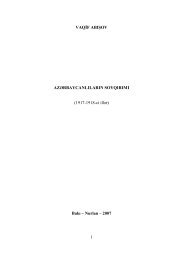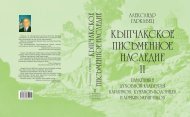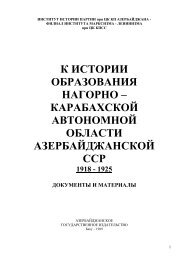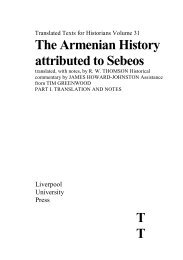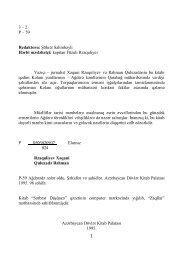ARMENIAN - Erevangala500
ARMENIAN - Erevangala500
ARMENIAN - Erevangala500
You also want an ePaper? Increase the reach of your titles
YUMPU automatically turns print PDFs into web optimized ePapers that Google loves.
*л *<br />
These drawings were done by proto-Turkish tribes living in<br />
eastern Anatolia thousands of years ago. Nomadic Turkish<br />
tribes still dominate the landscape o f the mountainous regions<br />
of eastern Anatolia. (Below: rock-drawings from the<br />
Kurbanaga Cave, not far from Cami§li, in the district o f Kars.)<br />
if<br />
There exist some very clear indications. Similar rock-<br />
drawings have been found in eastern Azerbaijan, in<br />
Kobistan, in the Altai region, and in Siberia. The density<br />
with which these rock-drawings occur shows beyond a<br />
doubt that they are of proto-Turkish origin. The people<br />
who made these drawings belonged to early nomadic and<br />
semi-nomadic Turkish tribes. A similar conclusion can be<br />
drawn in the case of the stylized drawings from the Geva-<br />
ruk Valley (Hakkari) and those on the Plateau o f Tirshin.<br />
The rock-drawings of Gevaruk and Tirshin are o f particular<br />
significance because they bear a strong resemblance to<br />
the drawings and symbols in the Cunni cave, near Erzurum,<br />
and on the stone blocks of the temple o f Zeus in<br />
Aizani (Cavdarhisar, near Kutahya). They were done by<br />
ancient Turkish clans of the region. The latest discoveries<br />
demonstrate clearly that there was already a connection in<br />
prehistoric times between eastern Anatolia and the artistic<br />
and cultural centers of the steppes o f Azerbaijan and<br />
Siberia, as well as the mountainous regions of the Altai -<br />
the original homeland of the Turkic peoples. From prehistoric<br />
days right up to modem times, wandering and semi-<br />
nomadic Turkish and proto-Turkish tribes have formed a<br />
living tie between Inner Asia and Anatolia.<br />
Asia is the home of the yurts. "Yurt" is a Turkish word<br />
meaning both "tent", "home" and motherland. Bee-hive<br />
houses, similar to yurts, can be seen in Anatolia. They are<br />
a creation o f the Hurrians, predecessors of the Urartians,<br />
whose realm lay between the Caucasus, Lake Urmia, and<br />
the region around Malatya-Elazig. Various local names<br />
have been given to this cultural zone. These include<br />
"Kura-Aras Culture" and "Karaz Culture". The creators<br />
and upholders of this culture spoke a language belonging<br />
to the Ural-Altaic family, to which Turkish also belongs.<br />
Early Hurri Culture together with Hurri Culture formed<br />
the foundation for the Urartian kingdom which followed.<br />
A characteristic feature of Hurrian culture was the round<br />
house, similar to the round tents of the semi-nomadic<br />
Hurrians. Round houses o f the Hurrian type can still be<br />
seen today in the region o f Urfa and Haran. The later<br />
Turkish domed buildings of the Ottoman period would<br />
appear to be a logical development from the yurt and the<br />
bee-hive house. It was the Greeks and the Romans who<br />
developed the techniques for constructing large domes,<br />
but the enthusiasm with which the Ottomans adopted<br />
these techniques is undoubtedly related to the ancient<br />
preference o f the Turkic peoples for round houses and<br />
yurts.<br />
Eastern Anatolian landscape above Lake Van. In Urartian times<br />
thick forests still covered these hills, but they were cleared long<br />
ago.<br />
19



